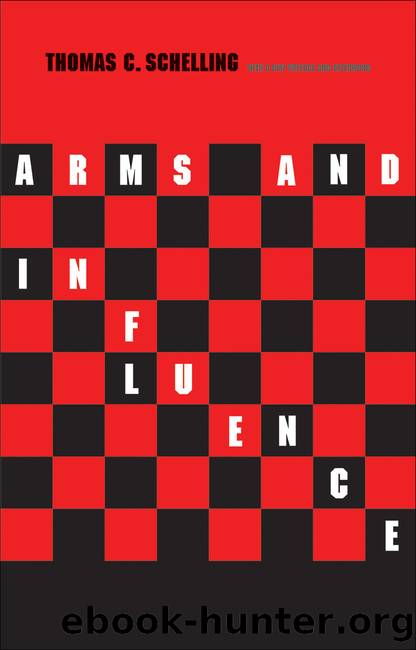Arms and Influence (The Henry L. Stimson Lectures Series) by Thomas C. Schelling

Author:Thomas C. Schelling [Schelling, Thomas C.]
Language: eng
Format: azw3
Publisher: Yale University Press
Published: 2008-10-01T00:00:00+00:00
Coercive Warfare
The theoretical question whether limits in warfare tend by nature to be qualitative, or can be matters of degree, assumed sudden relevance with the initiation of the bombing campaign in North Vietnam in February 1965. To approach the question it is helpful to remind ourselves what kind of conflict the Korean War had been. It was almost exclusively a battlefield war. There was little coercive exercise of the power to hurt, of the kind discussed in Chapter 1, except to the extent that it hurts when soldiers are killed and wounded and money is spent on war. The civilian pain and destruction were locally devastating, but they were incidental to the battlefield warfareâto the defeat and capture of enemy troops, to the conquest of local territory, to the destruction of supplies and military facilities. Neither sideâs military strategy was mainly concerned with how much civilian damage was being done locally and whether in view of that damage it made sense to abandon military objectives and to halt the war. The main power to hurt was held in reserve: the American ability to use nuclear bombs in China, the Soviet ability to hurt the United States or to threaten Western Europe, and any Soviet or Chinese ability to coerce Japan by the threat of bombing, remained latent. The power to hurt surely policed the boundaries of the war, deterring unilateral enlargement and keeping the Soviet Union and the United States from engaging each other directly. But the power to hurt, and susceptibility to hurt in return, circumscribed the war without being deliberately exercised in the conduct of that war.
Contrast the bombing of North Vietnam. This was not an all-out interdiction campaign, exclusively designed to cut supplies to the Vietcong; had it been that, there would have been little reason not to do the bombing on a larger scale at the outset. The bombing had an evident measure of coercive intent behind it: it was evidently designed, at least partly, to inflict plain loss of value on the adversary until he began to behave. The bombing was widely discussed, and sometimes explained by the Administration, as a means of putting pressure on the government of North Vietnam; and when extension to industrial establishments was discussed, it was not mainly in terms of slowing down the enemyâs war effort but of raising the cost of not coming to terms. The occasional hints and actual instances of conditional cessation of the bombing testified to its negotiatory character. The results of the bombing in North Vietnam, in contrast to that in the south, were to be sought in North Vietnamese willingness to comply, to accommodate, to withdraw, or to negotiate (as well as in setting a pattern, and possibly a warning, for the contingency of Communist Chinese participation).
The bombing still showed some tendency to stay within class distinctions. (Some of the perceived limits or class distinctions may have arisen by default: if the initial selection of targets omits certain whole areas or types of
Download
This site does not store any files on its server. We only index and link to content provided by other sites. Please contact the content providers to delete copyright contents if any and email us, we'll remove relevant links or contents immediately.
| Africa | Americas |
| Arctic & Antarctica | Asia |
| Australia & Oceania | Europe |
| Middle East | Russia |
| United States | World |
| Ancient Civilizations | Military |
| Historical Study & Educational Resources |
The Light of Days by Judy Batalion(1064)
First Platoon: A Story of Modern War in the Age of Identity Dominance by Annie Jacobsen(903)
Stalin's War: A New History of World War II by Sean McMeekin(861)
The Pacific War 1941-1943 by James Holland(803)
Walk in My Combat Boots by James Patterson(765)
The American War in Afghanistan by Carter Malkasian(743)
Victory's Price (Star Wars) by Alexander Freed(735)
The Vietnam War: An Intimate History by Geoffrey C. Ward & Ken Burns(722)
Blood and Ruins: The Great Imperial War, 1931-1945 by Richard Overy(686)
Operation Pedestal by Max Hastings(683)
Concepts of Space by Jammer Max;(667)
Cold War (Alexander King Book 2) by Bradley Wright(661)
Extreme Fitness by Chris McNab(654)
The Madman Theory by Jim Sciutto(651)
Flying Tiger by Samson Jack(635)
World War II Infantry Fire Support Tactics by Gordon L. Rottman(612)
Pathfinders by AL-KHALILI JIM(611)
Panzerkrieg by Mike Syron(601)
Hitler’s Pre-Emptive War: The Battle for Norway, 1940 by Henrik O. Lunde(585)
